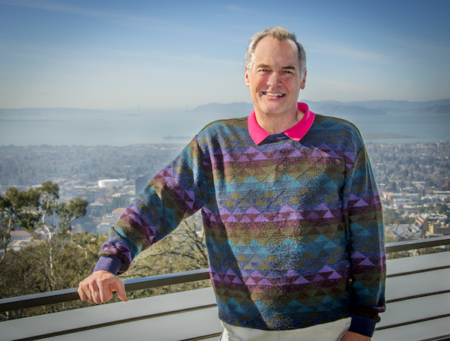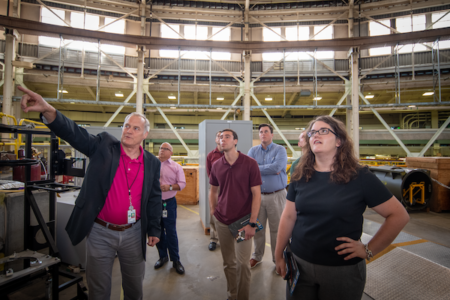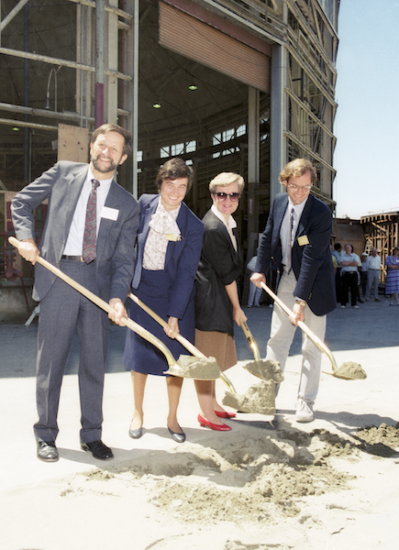
Steve Kevan, director of Berkeley Lab’s Advanced Light Source (ALS) since 2018, has announced that he will retire later this year. Associate Lab Director for Energy Sciences Jeff Neaton will soon initiate an international search for his replacement.
Kevan previously spent six years as the ALS science deputy and has conducted research as a scientific user of the facility since its inception nearly 30 years ago.
“Leading the ALS and serving the ALS user community have been highlights of my career, and I am very proud of what our staff and users have all accomplished together,” said Kevan.
“During Steve’s tenure, the ALS scientific programs and operations have flourished, and its staff and users continue to produce a wealth of world-class science, maintaining the ALS’s position as one of the world’s premier x-ray light sources,” said Neaton. “His passion for ALS staff and science have been truly inspiring.”

One of the most notable achievements of Kevan’s ALS tenure was leading the development of the science case for the ALS Upgrade (ALS-U) Project, a major long-term effort to replace the light source’s existing electron storage ring with an accelerating ring that leverages next-generation magnet technology. The upgrade will endow the ALS with revolutionary capabilities, particularly in its specialty area of lower-energy, “soft” x-rays, dramatically improving the ability of researchers from around the world to gain insights into complex materials and chemical processes.
“Steve leaves us with a world-class user facility that will greatly benefit the next generation of scientists,” said Mike Witherell, director of Berkeley Lab. “The ALS-U Project will position the ALS to remain a premier light source facility for the international user community.”
“Steve will have led the scientific vision for ALS-U from the early pre-project phase up to the construction phase,” said ALS-U Project Director Dave Robin. “I have had the great fortune to partner with him during that time, and it is hard for me to think of a more dedicated, selfless, and caring person who has contributed so much, ensuring an exciting future for the ALS.”

Kevan’s other noteworthy accomplishments as ALS director include restructuring the facility’s photon science group around technique-oriented “programs” and establishing the ALS Science Council, a group of staff and Berkeley Lab collaborators who advise leadership on scientific strategy. Both changes provided more career development opportunities for scientific staff, and the Science Council has helped initiate new partnerships with the user community and Berkeley Lab researchers.
Kevan also formally established the ALS’s Inclusion, Diversity, Equity, and Accountability Committee in alignment with Berkeley Lab’s initiative in this area. Over the last three years, approximately 50 staff have participated in the efforts to improve recruitment and hiring practices, work-life balance, staff recognition, and other areas of the ALS environment.
“I believe we’ve made a good start in these areas,” said Kevan. “Much remains to be done, and the long-term impact on ALS culture and innovation will be enormous.”
“Steve has provided excellent leadership of the ALS during an unprecedented period,” said Neaton. “He’s implemented a dynamic vision of the facility and expanded its central role in Berkeley Lab’s research programs and those of its distinguished international user community.”
Kevan began his career as a technical staff member at AT&T Bell Labs, following his PhD work at UC Berkeley in physical chemistry under David A. Shirley. He then moved to the University of Oregon, where he served as a professor of physics until his transition to emeritus professor last year.

Early in his faculty career, he contributed to the conceptual planning for the ALS. Shirley, his doctoral advisor, had since become director of Berkeley Lab and was leading the case to build the soft x-ray synchrotron facility. Kevan became one of the ALS’s first scientific users and has continued to leverage synchrotron light sources around the world for his work in surface and thin-film physics and exotic magnetism. Over the course of his career, he has mentored more than three dozen graduate students and postdocs, some of whom have continued in synchrotron-related fields.
Light sources internationally have sought his expertise as a member of their scientific advisory boards, and his contributions to the development of the angle-resolved photoemission spectroscopy technique were recognized by the American Physical Society’s Davisson-Germer Prize. His professional accomplishments also include the ALS David A. Shirley award for science and being elected a fellow of the American Physical Society and the American Association for the Advancement of Science.
Kevan intends to stay apprised of the ALS’s accomplishments, even in retirement. “I hope to keep up my 29-year streak as an ALS user,” he added, “and I look forward to following the progress of the ALS as it continues to serve a broad user community and create impactful science for decades to come.”